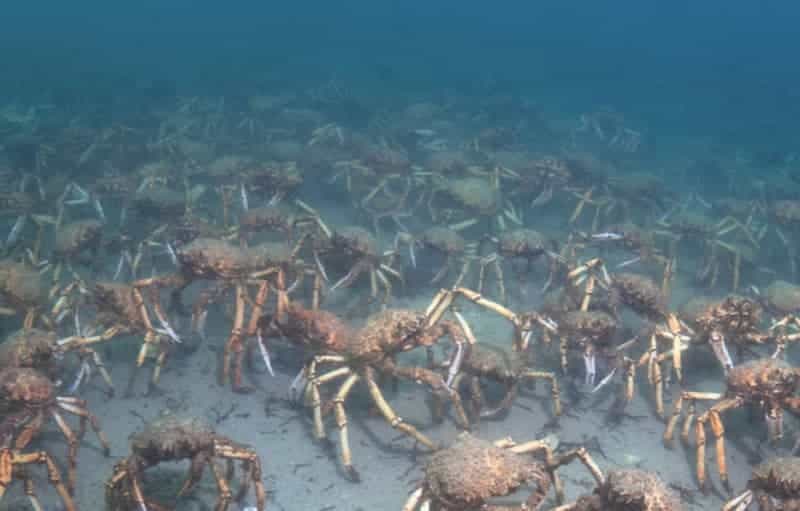PARK WATCH June 2020 |
Our Nature Conservation Campaigner Shannon Hurley rallies the community to speak out against the industrialisation of Westernport Bay.
For the past couple of years, AGL’s moves to industrialise Westernport Bay have been underway, and their plans for a Gas Import Terminal Facility are getting closer to crunch time.
In AGL’s proposed project, an industrial-sized 300-metre-long gas storage ship would be moored permanently at Crib Point south of Hastings. It would be fed by imported gas from interstate or overseas, by up to 40 additional large Liquid Natural Gas (LNG) carrier ships per year. The gas would then be connected to a new gas pipeline 60 kilometres long to join the gas network in Pakenham – to be developed and constructed by an energy infrastructure business APA Group.
VNPA, along with other statewide and local conservation groups, have opposed the project from the start, due to serious concerns of the potential impacts on marine life. Chlorine release into the bay, increase in shipping, and fuel spills could have flow on effects on migratory birds, marine mammals, and important fish habitat such as seagrass and mangroves. Not to mention the climate pollution that would be released at a time when we should be transitioning away from fossil fuels.
In our view, Westernport Bay is too sensitive and precious to risk. We have urged for, at the very least, for the project to undergo the most thorough environmental assessment. Thankfully this was granted by both the state and federal governments back in October 2018.
So where is the project at, and what lays ahead of us?
Where is the proposed project at?
For over 12 months, AGL has been ‘preparing’ their environmental assessment documents to submit for assessment by state and federal governments. At the state level this happens through an Environmental Effects Statement (EES) process, whereby AGL undertake and report their technical studies of the impacts of the proposed project on environmental and social values.
AGL has submitted their EES documentation to the Department of Environment Land Water and Planning (DELWP), who will review it and provide advice to the Planning Minister Richard Wynne. He then decides if the EES is suitable for public exhibition, which is expected in early June.
That’s where we come in.
Once made public, this is our opportunity as the community to have our say on AGL’s assessment, and provide feedback through written submissions. Public consultation is usually only open for a short window of 30 days.
Given the current Covid-19 restrictions (at the time of writing), it is being investigated to move the entire process online. We argue that removing opportunities for in-person consultation would seriously limit meaningful participation by the community, be unfair, and in favour of the proponents, AGL and APA. VNPA, and other state and local conservation groups have written to the Planning Minister to ask him to delay the EES process until either a thorough online process is developed, or the social distancing restrictions for COVID-19 have lapsed. Hopefully, the Minister decides in favour of the Victorian community.
When this next phase of the EES process does occur, several other planning-related state permits and approvals for the proposed project will be rolled into this one consultation process – meaning this will be our last opportunity to provide comment on those matters.
Further approvals are needed later on in relation to cultural heritage and marine and coastal consent under the Victorian Marine and Coastal Act 2018 and under the federal Environment Protection and Biodiversity Conservation Act 1999.
Right from the get-go from the scope of impacts AGL has been required to look at has not been comprehensive enough.
VNPA and Environment Victoria previously engaged marine ecologists at Australian Marine Ecology to look at the AGL’s previous studies when referring the project initially for the EES process. This work showed significant gaps in AGL’s initial studies, including a lack of acknowledgement of:
- the impacts the project could have on the bay as a whole, by only considering impacts in the immediate vicinity of the project;
- the impact chlorine can have once released into the bay;
- the risk of catastrophic impacts associated with additional shipping in the bay.
For anyone with knowledge about the movements of water and marine species throughout Westernport Bay, it would be clear this project has the capacity to impact the bay on a much larger scale – a severe oversight so far by the state government and AGL.
What lays ahead of us?
After the public exhibition ends, it is likely an independent panel will assess and run a series of ‘hearings’, an opportunity for experts to comment and ask questions on AGL’s studies, and AGL and APA to respond with their views.
Then the state Planning Minister and federal Environment Minister will need to decide if the project will have acceptable levels of environmental effects, and approve it – or not.
The process will likely take place over a series of months, with final decisions from state and federal government expected by the end of this year/early next year.
This entire period will be an important time for us as a community to continue to stand up for our precious Westernport Bay, but the upcoming public exhibition will be the one and only time for formal comment.
You can help by having your say when the community consultation opens – keep informed by signing up to our email updates.
Did you like reading this article? Want to be kept up to date about this and other nature issues in Victoria? Subscribe to our email updates.
You can also receive our print magazine Park Watch four times a year by becoming a member. Find out more here.
